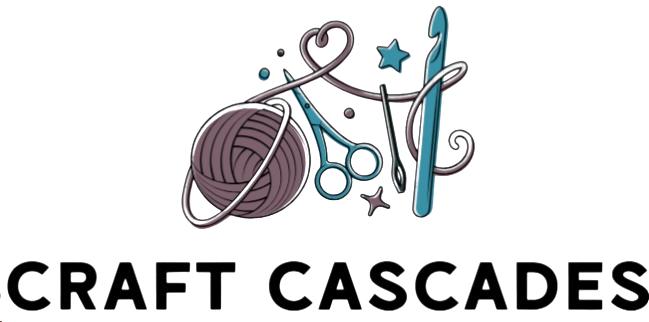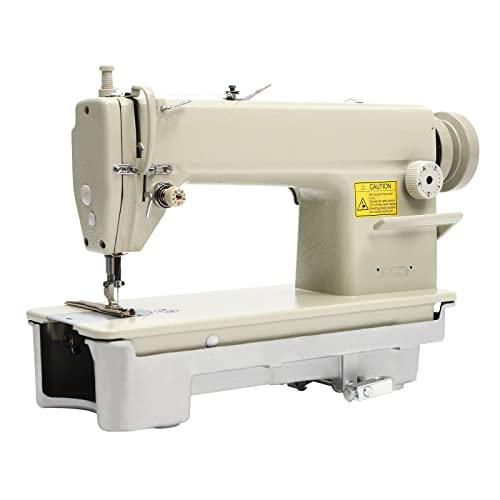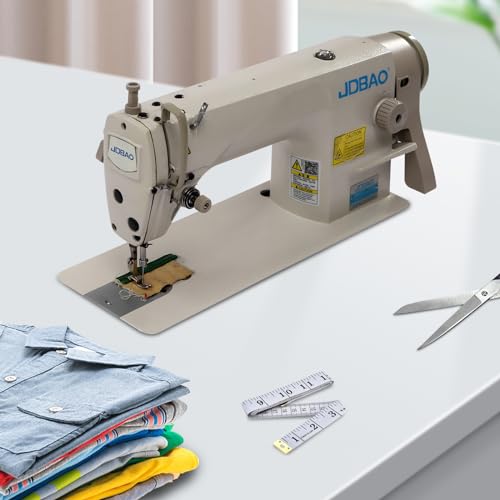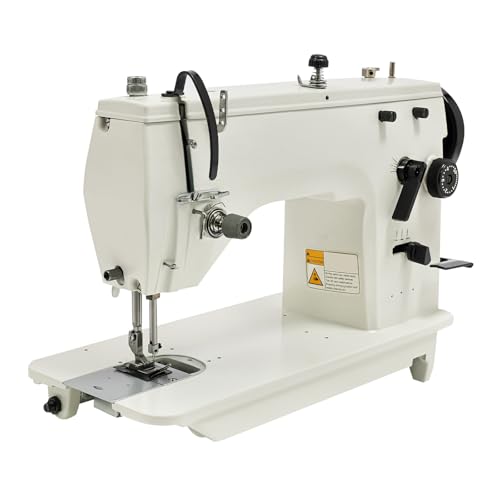When you’re tackling heavy-duty upholstery projects, you’ll quickly uncover that your standard home sewing machine won’t cut it. You need industrial-grade power, speed, and durability to handle thick fabrics, leather, and multiple layers without constant thread breaks or motor strain. But with dozens of models claiming to be “industrial-strength,” how do you separate the genuine workhorses from the pretenders? We’ve tested and compared the top contenders to help you make the right investment.
SINGER Heavy Duty 6700C Computerized Sewing Machine
The SINGER Heavy Duty 6700C stands out as an excellent choice for sewers who need a versatile machine that can handle upholstery projects without breaking the bank. You’ll appreciate its powerful motor that effortlessly pierces through thick fabrics like denim and leather, while 411 stitch applications give you creative flexibility. The LCD screen lets you monitor settings at a glance, and the included walking foot guarantees even feeding of multiple layers. At 14.6 pounds, it’s portable yet stable. With 853 reviews averaging 4.3 stars, users praise its reliability for heavy-duty work, though some note occasional tension issues with certain fabrics.
Best For: Beginners to mid-level sewers who need a reliable, versatile machine for heavy-duty projects including garments, home decor, quilting, and upholstery work with thick fabrics.
Pros:
- Powerful motor with enhanced piercing power handles thick materials like denim, leather, and multiple layers with ease
- 411 stitch applications including decorative stitches, 7 buttonhole styles, and lettering font provide extensive creative options
- Comprehensive accessory package includes 10 presser feet (including walking foot), LCD screen for easy stitch monitoring, and affordable price point
Cons:
- Tension issues reported by some users when working with certain fabrics
- Plastic components may affect long-term durability and overall build quality
- Performance inconsistencies noted on some fabric types despite heavy-duty designation
Industrial Straight Stitch Sewing Machine for Leather, Rubber, Canvas (6150)
Heavy-duty leather workers and craftsmen who regularly tackle thick, resistant materials will find the 6150 Industrial Straight Stitch Sewing Machine their ideal workhorse. This fuel-powered machine excels at sewing leather, rubber, and canvas for boots, bags, and cylindrical goods. You’ll appreciate its adjustable gauge (1-5), reverse stitch capability, and manual presser foot control for precise work. The automatic bobbin winder and oil return pump enhance efficiency during extended projects. At 56 pounds, this iron-constructed machine delivers commercial-grade performance. However, its 1.0-star rating warrants careful consideration. Note that motors and tables aren’t included with purchase.
Best For: Heavy-duty leather workers, cobblers, and craftsmen who regularly sew thick materials like leather, rubber, and canvas for boots, bags, and other industrial applications.
Pros:
- Handles thick, resistant materials with fuel-powered performance and adjustable gauge settings (1-5) for versatile stitch control
- Time-saving features include automatic bobbin winder and oil return pump with quantity monitoring for efficient extended use
- Precise control capabilities with reverse stitch function, manual presser foot wrench, and adjustable thread tension for professional results
Cons:
- Extremely low customer rating of 1.0 out of 5 stars raises serious concerns about quality and reliability
- Motor and table not included with purchase, requiring additional significant investment to make the machine operational
- Heavy weight of 56 pounds and fuel-powered operation may limit portability and require dedicated workspace with proper ventilation
6500RPM Industrial Sewing Machine, Heavy Duty for Leather & Upholstery
Professional upholstery shops and alteration stores seeking maximum productivity will find the 6500RPM Industrial Sewing Machine ideally suited to their demanding workloads. You’ll appreciate its cast iron shell and heat-treated construction, which guarantees long-term durability under continuous commercial use. The double thread large rotary hook delivers up to 3000 stitches per minute, substantially boosting your output. Its lower feeding method effectively handles medium and thick fabrics like leather and upholstery materials. You can quickly adjust needle positioning up to 0.3 inches using the locking design knob. The automatic oil spraying device maintains proper lubrication while minimizing operational noise throughout extended production runs.
Best For: Professional upholstery shops, alteration stores, and industrial sewing operations that require high-speed stitching capabilities for leather, thick fabrics, and heavy-duty commercial applications.
Pros:
- High productivity with 3000 stitches per minute capability and double thread large rotary hook for commercial-grade output
- Durable cast iron shell with heat-treated construction designed to withstand continuous industrial use
- Automatic oil spraying device ensures proper lubrication and low noise operation during extended production runs
Cons:
- Heavy weight at 66.8 pounds makes portability and repositioning difficult
- Limited needle adjustment range of only 0.3 inches may restrict versatility for certain specialized projects
- Unclear model number (sadsdsdd) and future release date (June 13, 2025) raise questions about product legitimacy and availability
Industrial Straight Stitch Sewing Machine Heavy Duty with Adjustable Stitch Clamp
For upholstery professionals seeking a machine that handles thick fabrics with precision, this industrial straight stitch model delivers exceptional performance through its adjustable stitch clamp system. You’ll appreciate the cast iron construction that resists deformation during heavy-duty projects, while the spraying process enhances longevity. The machine processes materials up to 4mm thick with adjustable gauge settings from 1-5, giving you complete control over stitch density. You can modify bottom thread tightness for customized results and utilize reverse stitch functionality for reinforced seams. The manual presser foot spanner simplifies thread management, making this compact 15.7 x 7.1 x 11.4-inch unit practical for both factory and home environments.
Best For: Upholstery professionals and garment makers who work with thick, heavy-duty fabrics and need precise stitch control in both factory and home workshop settings.
Pros:
- Durable cast iron construction with spray-treated finish resists wear and deformation for long-term industrial use
- Adjustable gauge settings (1-5) and customizable bottom thread tightness provide precise control over stitch density and quality
- Handles thick materials up to 4mm with reverse stitch functionality for reinforced seams on heavy-duty projects
Cons:
- Limited to straight stitch only with minimal zig-zag capability (maximum 0.354 inches), restricting decorative sewing options
- Manual presser foot operation and handwheel needle control require more physical effort compared to automated systems
- Compact dimensions may limit workspace for handling large upholstery or industrial-scale projects
SINGER Heavy Duty 4452 High Speed Sewing Machine with Accessory Kit
The SINGER Heavy Duty 4452 stands out with its 1,100 stitches-per-minute capability and sturdy metal frame, making it an excellent choice for sewists who need reliable power without the price tag of true industrial machines. You’ll appreciate the 110 stitch applications and built-in needle threader for quick setup. The machine includes six presser feet, bobbins, and essential accessories to handle various upholstery projects. However, you should note that some users report difficulties with presser foot changes and limitations when sewing multiple fabric layers. It’s best suited for light to medium upholstery work rather than extensive heavy-duty applications.
Best For: Sewists seeking a powerful, affordable machine for light to medium upholstery projects and heavy-duty sewing tasks who value speed and versatility without requiring industrial-grade capabilities.
Pros:
- Strong motor with 1,100 stitches-per-minute capability and enhanced piercing power handles thick fabrics effectively
- Comprehensive package includes 110 stitch applications, built-in needle threader, and six presser feet for various sewing needs
- Durable metal frame construction provides stability during high-speed operation at a more accessible price point than industrial machines
Cons:
- Presser foot changes and adjustments can be difficult and time-consuming to perform
- Limited performance when sewing multiple fabric layers and some issues with zig-zag stitching consistency
- Higher noise levels during operation and cleaning the machine can be challenging
JUKI DDL8700H High-Speed Lock-Stitch Sewing Machine for Heavy Material (Head Only)
Heavy-duty fabric specialists will find their match in the JUKI DDL8700H, a powerhouse that tackles everything from thick denim to marine vinyl with impressive 4,000 rpm speed. You’ll appreciate the 13mm foot lift and 5mm maximum stitch length, designed specifically for professional curtain makers and leather workers. However, you’ll need to budget for a motor and table separately, as this head-only unit doesn’t include them. The auto-lubrication system keeps your hook running smoothly, while the adjustable reverse feed adds versatility. At 74.8 pounds, it’s built for serious workloads, earning a solid 3.9-star rating from professional users.
Best For: Professional sewers and businesses working with heavy-duty materials like leather, denim, marine vinyl, and canvas who need a high-speed industrial machine and already have or are willing to purchase a separate motor and table.
Pros:
- Exceptional 4,000 rpm sewing speed with auto-lubrication system enables efficient handling of heavy materials from jeans to boat canvas
- 13mm higher foot lift and 5mm maximum stitch length provide versatility for thick, layered fabrics
- Strong performance rating (#4 in Industrial Machines category) with proven reliability for medium to heavy workloads
Cons:
- Motor and table sold separately, requiring additional investment beyond the initial purchase price
- Not a walking foot machine, which may limit functionality for certain heavy-duty applications
- At 74.8 pounds for head only, requires substantial workspace setup and is not portable
Industrial Sewing Machine with Motor & Table Stand (550W)
Professional upholsterers who need a complete, ready-to-use workstation will find this 550W industrial sewing machine delivers exceptional value. This package includes everything you’ll need: a powerful servo motor, sturdy table stand, and the sewing machine itself. The 550W motor provides ample power for tackling heavy upholstery materials while maintaining precise control. You won’t waste time assembling separate components since it arrives as an integrated system. First available in July 2023, it’s quickly gained traction, ranking #2,929 among sewing machines. The complete setup eliminates compatibility concerns between motor and machine, letting you start projects immediately.
Best For: Professional upholsterers and heavy-duty sewing professionals who need a complete, integrated workstation with sufficient power to handle thick upholstery materials and demanding projects.
Pros:
- Complete all-in-one system includes 550W servo motor, table stand, and machine, eliminating compatibility issues and allowing immediate use
- Powerful 550W motor provides ample strength for heavy upholstery fabrics while maintaining precise control
- Strong market performance with #2,929 ranking in sewing machines category demonstrates customer satisfaction and reliability
Cons:
- Relatively low overall ranking of #1,100,215 in Arts, Crafts & Sewing category suggests limited general appeal or availability
- Recently released product (July 2023) means limited long-term reliability data and customer reviews
- Complete integrated system may be less flexible for users who already own compatible components or prefer customized setups
Factors to Consider When Choosing an Industrial Sewing Machine for Upholstery
When you’re shopping for an industrial sewing machine for upholstery work, you’ll need to evaluate several critical specifications that directly impact your results. The right machine must handle thick, layered materials while maintaining consistent stitch quality through long production runs. Key factors include motor power and speed capabilities, maximum material thickness capacity, stitch reliability, overall construction durability, and presser foot lift height for accommodating bulky fabrics.
Motor Power and Speed
One of the most critical specifications you’ll encounter while shopping for an industrial upholstery machine is motor power, typically ranging from 550W to over 1,000W. This power directly determines your machine’s ability to pierce through thick materials like leather and multiple fabric layers. Higher wattage means enhanced piercing capability and smoother operation when tackling demanding projects.
You’ll also want to take into account sewing speed, which can reach up to 4,000 stitches per minute in top industrial models. This dramatically boosts your productivity on heavy-duty tasks. Look for machines with adjustable speed control—this feature lets you match the pace to specific upholstery requirements, giving you better precision and control. Additionally, efficient motors with automatic lubrication and low noise operation guarantee consistent stitching quality.
Material Thickness Capacity
Material thickness capacity stands as your machine’s most fundamental specification for upholstery work, determining whether you’ll breeze through heavy projects or struggle with each seam. You’ll need a machine that handles at least 4mm of fabric thickness to work effectively with leather, canvas, and multiple material layers. Look for models with adjustable presser foot pressure and robust motors—these features let you manage varying fabric types without performance drops. Pay attention to needle configurations designed for thicker threads, as they create stronger, more durable seams. Verify the machine accommodates your required stitch types and maximum sewing lengths, typically around 0.5cm, to guarantee versatility across different upholstery applications.
Stitch Quality and Consistency
Your upholstery projects demand stitch quality that matches the premium materials you’re working with—inconsistent stitching ruins even the finest leather or fabric. Look for machines with locking stitch mechanisms and adjustable stitch lengths around 5 mm, which secure seams while accommodating different materials. High-speed machines producing up to 3000 stitches per minute maintain consistency without sacrificing quality, boosting your productivity considerably.
Consistent tension control is non-negotiable—it prevents puckering and thread breaks across varying fabric thicknesses. You’ll achieve uniform results whether you’re working with delicate textiles or heavy-duty materials. Machines built with cast iron frames and automatic oiling systems deliver reliable performance over time, ensuring your stitch quality remains consistent throughout production runs. These features directly impact your finished product’s appearance and durability.
Durability and Build Construction
When you’re investing in an industrial upholstery machine, the build construction determines whether you’ll have a reliable workhorse or a maintenance headache. Look for machines constructed from heavy-duty materials like cast iron and aluminum. These materials guarantee stability and resistance to wear over time. A solid metal frame minimizes vibrations during operation, delivering smoother sewing experiences on thick upholstery materials.
Heat-treated constructions offer enhanced strength and longevity under heavy workloads, making them ideal for demanding upholstery projects. Don’t overlook the machine’s overall weight—heavier models typically provide better durability and performance for upholstery tasks.
Consider machines with components designed for easy maintenance. Automatic lubrication systems extend your machine’s lifespan while reducing downtime, guaranteeing you’re spending more time sewing and less time troubleshooting mechanical issues.
Presser Foot Lift Height
Beyond solid construction, you’ll need adequate clearance beneath the presser foot to work with thick upholstery materials. A presser foot lift height of 13 mm or more is essential for handling bulky items like cushions, furniture pieces, and multiple fabric layers effectively.
Without sufficient lift height, you’ll encounter difficulties sewing heavy materials, leading to uneven stitches and machine jams. Look for machines with adjustable presser foot lift mechanisms that let you customize clearance based on your fabric type and project requirements.
For enhanced ergonomics in heavy-duty applications, consider models featuring manual or knee-operated lift systems. These allow you to manipulate thick fabrics more easily while maintaining control over your work, making them invaluable for professional upholstery projects.
Lubrication and Maintenance Systems
Industrial upholstery machines demand robust lubrication systems to withstand the constant friction and stress of heavy-duty sewing. You’ll want to prioritize machines with automatic oil pumps that guarantee consistent lubrication during operation, preventing overheating and component wear.
Regular maintenance is essential—you should check oil levels frequently and verify that all lubrication points function properly. A well-maintained system minimizes friction, allowing faster sewing speeds without sacrificing stitch quality.
Your lubrication frequency depends on usage intensity, but establish regular intervals to prevent mechanical failure. Always use lubricants with proper viscosity suited to your materials. Incorrect lubricants can damage components or compromise stitch quality. Investing in a machine with an efficient lubrication system reduces downtime and extends your equipment’s lifespan considerably.
Needle and Thread Compatibility
Selecting the right needle and thread combination directly impacts your machine’s performance and the quality of your upholstery work. For heavy materials like leather and canvas, you’ll need specialized needles ranging from DP x 5 to DP x 17. Your thread choice matters too—nylon offers superior strength, polyester provides excellent durability, and cotton delivers a traditional finish.
Always match your thread thickness to your needle size. Larger needles accommodate heavier threads, preventing breakage and guaranteeing long-lasting seams. You’ll need to adjust thread tension carefully, especially when working with multiple fabric layers, to achieve consistent stitch quality.
Verify your machine supports essential stitch types like lock-stitch or zig-zag configurations. Check the maximum sewing length capacity to confirm it handles your typical upholstery projects effectively.
Table and Motor Inclusion
Understanding what’s included in your purchase can save you hundreds of dollars and prevent setup headaches. Many industrial sewing machines are sold as standalone heads, requiring you to buy the motor and table separately. This greatly increases your total investment and complicates setup.
Look for packages that include a motor—typically rated at 550W for upholstery work—and a dedicated table stand. These complete setups provide better value and guarantee all components work together seamlessly. The motor’s power rating determines whether you’ll successfully handle thick upholstery materials during heavy use.
Check if the machine supports servo motors, which offer superior speed control and energy efficiency compared to clutch motors. A quality table stand reduces vibration and enhances precision, making your upholstery projects easier to execute.








